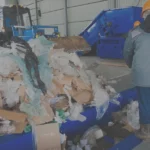If you’re as passionate about recycling as I am, you’ve probably wondered what happens to all those items you diligently toss into your recycling bin. Does everything truly get recycled, or is there more to the story?
We’ll delve into the recycling process, separating fact from fiction and uncovering the truth about what happens to your recycling bin contents.
Understanding the Recycling Process
Before we unveil the recycling reality, it’s crucial to grasp how the recycling process works. Recycling typically involves these key steps:
- Collection: Recycling trucks pick up materials from your curb or local drop-off points. These materials are then transported to recycling facilities.
- Sorting: At recycling facilities, the materials undergo a sorting process. This involves separating paper, cardboard, glass, plastics, and metals into distinct categories.
- Cleaning: The sorted materials are cleaned to remove contaminants like food residue or non-recyclable items.
- Processing: Cleaned materials are processed into raw materials, ready for manufacturers to use in creating new products.
- Manufacturing: Manufacturers use these recycled materials to produce new products, closing the recycling loop.
Now that we’ve laid out the recycling journey, let’s address the burning question.
The Recycling Rate Reality
It’s time for some transparency: not everything that goes into recycling bins ends up being recycled. The actual recycling rate can vary widely based on factors like location, the type of material, and the effectiveness of local recycling programs. On average, the recycling rate in the United States hovers around 32% of all waste generated, according to the Environmental Protection Agency (EPA).
So, what happens to the other 68% of materials? Here’s a closer look:
1. Contamination Concerns:
Contamination remains a significant issue in recycling. Items like greasy pizza boxes or non-recyclable plastics can render entire batches of recyclables unrecyclable. When in doubt, it’s better to toss questionable items into the trash to prevent contamination.
2. Market Demand Matters:
Recycling isn’t solely about good intentions; it’s a business influenced by market demand. If there’s no demand for recycled glass, for instance, it may not get recycled despite being collected.
3. Regional Variations:
Recycling programs vary by region, and some areas may have more robust recycling infrastructures than others. This means that what gets recycled can differ significantly depending on where you live.
Improving Recycling Rates
While the current recycling rate isn’t as high as we’d like, there’s always room for improvement. Here are some practical steps we can take to boost recycling rates:
1. Educate Yourself:
Learn what can and cannot be recycled in your area. Familiarize yourself with local recycling guidelines to minimize contamination.
2. Rethink Consumption:
Reduce waste at the source by making mindful choices when shopping. Opt for products with minimal packaging and choose reusable items over disposable ones.
3. Support Recycling Initiatives:
Advocate for recycling programs in your community. Encourage local businesses and schools to implement recycling practices.
4. Proper Disposal:
Dispose of hazardous materials, like batteries and electronics, at designated drop-off locations. These items require specialized recycling processes.
5. Reduce and Reuse:
Remember the three Rs: Reduce, Reuse, Recycle. Reduce your consumption, reuse items whenever possible, and recycle responsibly.
In Conclusion
While not everything that enters recycling bins ultimately gets recycled, recycling remains a vital practice in reducing waste and conserving resources. By understanding the recycling process, minimizing contamination, and advocating for recycling initiatives, we can collectively work toward improving recycling rates. Remember, recycling is a journey, and every effort counts in preserving our planet for future generations. So, keep recycling, stay informed, and inspire others to join the cause. Together, we can make a meaningful impact!


